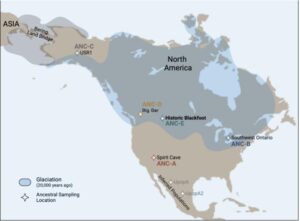
AMERICAN ASSOCIATION FOR THE ADVANCEMENT OF SCIENCE (AAAS)—A new study* describes a previously unidentified genetic lineage from which the modern-day Blood (Kainai) First Nation/Blackfoot Confederacy descended. Through comparisons of DNA from both Ancestral and modern-day Confederacy members, the work dates this Historic Blackfoot lineage to the late Pleistocene, corroborating established oral and archaeological records. The Blackfoot Confederacy is made of member tribes with ancestral ties to nomadic bison hunters that lived across the Northwestern Plains and Rocky Mountain Front. Oral and archaeological records place them in this region during the end of the last glaciation by at least 10,000 years ago. Yet, the Blackfoot’s legacy has been contested frequently in land and water rights lawsuits. “The objectives of this study were not only to advance scientific knowledge about Indigenous genomic lineages that can provide insight into the peopling of the Americas but also to provide the Blackfoot with an independent line of evidence for evaluating purported ancestral relationships with other North American groups,” Dorothy First Rider and colleagues write. Here, First Rider et al. analyzed samples from 7 historical Ancestors and 6 living Blackfoot people. They found that ancient and modern DNA had a high proportion of shared alleles, demonstrating genetic continuity over millennia. Further modeling suggests that the Blood/Blackfoot ancient lineage split from other ancestral Indigenous American groups roughly 18,000 years ago. Athabascan and Karitiana then separated from this Historic Blackfoot group 13,000 years ago. Notably, the investigations help answer why Blackfoot language has minimal linguistic overlap with other Algic (or Indigenous North American) languages such as central Algonquian. “Certain elements of Blackfoot are older than proto-Algonquian language and likely were spoken by Indigenous peoples in the aboriginal homelands of the Blackfoot Confederacy,” the authors explain. “This finding changes the traditional anthropological assumption that the Blackfoot language (and, by extension, its speakers) originated in the North American Great Lakes, where Algonquian purportedly evolved.” They add that Historic Blackfoot likely traveled from west to east to end up in the Northwestern Plains.
_______________________________

Genomic lineages of the Americas that evolved in the Late Pleistocene. Nomenclature follows from (22) with USR1 (2) representing ANC-C, Big Bar (3) representing ANC-D and Historic Blackfoot representing ANC-E. Rider et al., Sci. Adv. 10, eadl6595 (2024)
_______________________________
Article Source: Science Advances news release
*Genomic analyses correspond with deep persistence of peoples of Blackfoot Confederacy from glacial times, Science Advances, 3-Apr-2024. www.science.org/doi/10.1126/sciadv.adl6595
_______________________________
Read exciting, in-depth, richly illustrated premium articles with a premium subscription to Popular Archaeology for only $9.00 a year.
_______________________________
Advertisement





